Studies on Crop Yields and Their Extreme Value Analysis over India
Abstract
:1. Introduction
2. Data and Methodology
3. Trend Analysis of Major Crop Yields of India
4. Crop Yields and Irrigation over India
5. Relation between Crop Yields and Crop Products over India
6. Extreme Value Analysis of Major Crop Yields over India
7. Conclusions
- (i)
- A strong dependence of crop yields on irrigation but the relation of cropped area, crop production with irrigation is distinctly varied over India.
- (ii)
- The rice products are dominant compared to other crop products of wheat and maize with an average value of 104.5 kg capita−1 year−1 where the usage of wheat products are gradually increasing by the year 2013.
- (iii)
- Sufficient amount of rainfall is required to minimize the food inadequacy over India despite of its irrigation system.
- (iv)
- Rice, maize and jowar crops need to be paid more attention to increase their yields which is not sufficient with their present increasing rates to meet the increasing population food demands by 2050.
Author Contributions
Funding
Conflicts of Interest
References
- Barbosa, H.; Lakshmi Kumar, T.V. Strengthening regional capacities for providing remote sensing decision support in drylands in the context of Climate variability and change. In International Perspectives on Global Environmental Change; Young, S., Silvern, S., Eds.; InTech: Rijeka, Croatia, 2012. [Google Scholar]
- Ray, K.D.; Gerber, J.S.; MacDonald, G.K.; West, P.C. Climate variation explains a third of global crop yield variability. Nat. Commun. 2015, 6, 5989. [Google Scholar] [CrossRef] [PubMed]
- Sonkar, G.; Mall, R.K.; Banerjee, T.; Singh, N.; Lakshmi Kumar, T.V.; Chand, R. Vulnerability of Indian wheat against rising temperature and aerosols. Environ. Pollut. 2019, 254, 112946. [Google Scholar] [CrossRef] [PubMed]
- He, W.; Yang, J.Y.; Qian, B.; Drury, C.F.; Hoogenboom, G.; He, P.; Lapen, D.; Zhou, W. Climate change impacts on crop yield, soil water balance and nitrate leaching in the semiarid and humid regions of Canada. PLoS ONE 2018, 13, e0207370. [Google Scholar] [CrossRef] [PubMed]
- Brown, L.S. Rescuing a Planet under Stress and a Civilization in Trouble, 1st ed.; Earth Policy Institute, W.W. Norton & Company: New York, NY, USA, 2003. [Google Scholar]
- Ray, K.D.; Mueller, D.N.; West, C.P.; Foley, A.J. Yield trends are insufficient to double global crop production by 2050. PLoS ONE 2013, 8, e66428. [Google Scholar] [CrossRef] [PubMed]
- Parthasarathy, B.; Munot, A.A.; Kothawale, D.R. Regression model for estimation of Indian food grain production from summer monsoon rainfall. Agric. Meteorol. 1988, 42, 167–182. [Google Scholar] [CrossRef]
- Selvaraju, R. Impact of El Nino—Southern Oscillation on Indian foodgrain production. Int. J. Climatol. 2003, 23, 187–206. [Google Scholar] [CrossRef]
- Krishna Kumar, K.; Rupa Kumar, K.; Ashrit, R.G.; Deshpande, N.R.; Hansen, J.W. Climate Impacts on Indian agriculture. Int. J. Climatol. 2004, 24, 1375–1393. [Google Scholar] [CrossRef]
- Madhu, S.; Lakshmi Kumar, T.V.; Barbosa Humberto Koteswara Rao, K.; Vizaya Bhaskar, V. Trend analysis of evapotranspiration and its response to droughts over India. Theor. Appl. Climatol. 2014, 121, 41–51. [Google Scholar] [CrossRef]
- Adejuwon, O.J. Food crop production in Nigeria. I. Present effects of climate variability. Clim. Res. 2005, 30, 53–60. [Google Scholar] [CrossRef]
- Asada, H.; Matsumoto, J. Effects of rainfall variation on rice production in the Ganges—Brahmaputa basin. Clim. Res. 2009, 38, 249–260. [Google Scholar] [CrossRef]
- Tubiello, F.N.; Rosenzweig, C.; Goldberg, R.A.; Jagtap, S.; Jones, J.W. Effects of climate change on US crop production: Simulation results using two different GCM scenarios. Part I.; Wheat. potato, maize and citrus. Clim. Res. 2002, 20, 259–270. [Google Scholar] [CrossRef]
- Intergovernmental Panel on Climate Change (IPCC). Climate Change 2001: The scientific basis. In Contribution of Working Group I to the Third Assessment Report of the IPCC; Houghton, J.T., Ding, Y., Griggs, D.J., Noguer, M., vander Linden, P.J., Dai, X., Maskell, K., Johnson, C.A., Eds.; Cambridge University Press: Cambridge, UK, 2001. [Google Scholar]
- Salinger, M.J. Climate variability and change: Past. present and future—An overview. Clim. Chang. 2005, 70, 9–29. [Google Scholar] [CrossRef]
- Kropff, M.J.; Matthews, R.B.; Van Laar, H.H.; Ten Berge, H.F.M. Modelling the Impact of Climate Change on Rice Production in Asia; IRRI and CAB International: Wallingford, UK, 1995; pp. 27–50. [Google Scholar]
- Tilman, D.; Balzer, C.; Hill, J.; Befort, L.B. Global food demand and the sustainable intensification of agricultute. Proc. Natl. Acad. Sci. USA 2011, 108, 20260–20264. [Google Scholar] [CrossRef] [PubMed]
- Koteswara Rao, K.; Lakshmi Kumar, T.V.; Lakshmana Rao, V. Variability of agroclimatic regime of homogeneous monsoon regions of India. Glob. Planet. Chang. 2012, 92, 48–57. [Google Scholar]
- Lakshmi Kumar, T.V.; Koteswara Rao, K.; Barbosa, H.; Jothi, E.P. Studies on spatial patterns of NDVI over India and its relationship with rainfall, air temperature, soil moisture adequacy and ENSO. Geofizika 2013, 30, 73–89. [Google Scholar]
- Didan, K. MOD13C2 MODIS/Terra Vegetation Indices Monthly L3 Global 0.05 Deg CMG V006. NASA EOSDIS Land Processes Distributed Active Archive Center (LP DAAC), Located at the US. Available online: https://ladsweb.modaps.eosdis.nasa.gov/missions-and-measurements/products/MOD13C2/ (accessed on 26 August 2019).
- Lakshmi Kumar, T.V.; Uma, R.; Koteswara Rao, K.; Barbosa, H.; Patnaik, K.V.K.R.K.; Jothi, E.P. Variability in MODIS NDVI and its relationship with southwest monsoon rainfall over Western Ghats, India. J. Environ. Inform. 2016, 27, 52–61. [Google Scholar] [CrossRef]
- Lakshmi Kumar, T.V.; Uma, R.; Koteswara Rao, K.; Barbosa, H.; Patnaik, K.V.K.R.K. On the relation of vegetation with the southwest monsoon rainfall over Western Ghats, India. Nat. Hazards 2016, 84, 425–436. [Google Scholar] [CrossRef]
- FAO. Food Balance Sheets; Part of FAOSTAT—FAO Database for Food and Agriculture; Food and Agriculture Organization of UN: Rome, Italy, 2003. [Google Scholar]
- Gumbel, E.J. Statistics of Extremes; Columbia University Press: New York, NY, USA, 1958. [Google Scholar]
- Sarma, A.A.L.N.; Lakshmi Kumar, T.V.; Koteswara Rao, K. Extreme value analysis of south west monsoon rainfall over Andhra Pradesh. Indian J. Radio Space Phys. 2010, 39, 32–38. [Google Scholar]
- Lakshmi Kumar, T.V.; Koteswara Rao, K.; Barbosa, H.; Uma, R. Trends and extreme value analysis of rainfall pattern over homogeneous monsoon regions of India. Nat. Hazards 2014, 73, 1003–1017. [Google Scholar] [CrossRef]
- Sarma, A.A.L.N.; Lakshmi Kumar, T.V. Studies on crop growing period and NDVI in relation to water balance components. Ind. J. Radio Space Phy. 2006, 35, 424–434. [Google Scholar]
- Revadekar, J.V.; Tiwari, Y.K.; Ravi Kumar, K. Impact of climate variability on NDVI over the Indian region during 1981—2010. Int. J. Remote Sens. 2012, 33, 7132–7150. [Google Scholar] [CrossRef]
- Sarma, A.A.L.N.; Lakshmi Kumar, T.V.; Koteswara Rao, K. Development of an agroclimatic model for the estimation of rice yield. J. Indian Geophys. Union 2008, 12, 89–96. [Google Scholar]
- Glahn, H.R. Canonical correlation and its relationship to discriminant analysis and multiple regressions. J. Atmos. Sci. 1968, 25, 23–31. [Google Scholar] [CrossRef]
- Dieleman, J.A.; Mortensen, D.A.; Buhler, D.D.; Cambardella, C.A.; Moorman, T.B. Identifying associations among site properties and weed species abundance: I Multivariate analysis. Weed Sci. 2000, 48, 567–575. [Google Scholar] [CrossRef]
- Dodd, M.B.; Lauenroth, W.K.; Burke, I.C.; Chapman, P.L. Associations between vegetation patterns and soil texture in the shortgrass steppe. Plant Ecol. 2002, 158, 127–137. [Google Scholar] [CrossRef]
- Martin, F.N.; Bollero, G.; Bullock, D.G. Associations between field characteristics and soyabean plant performance using canonical correlation analysis. Plant Soil 2005, 273, 39–55. [Google Scholar] [CrossRef]
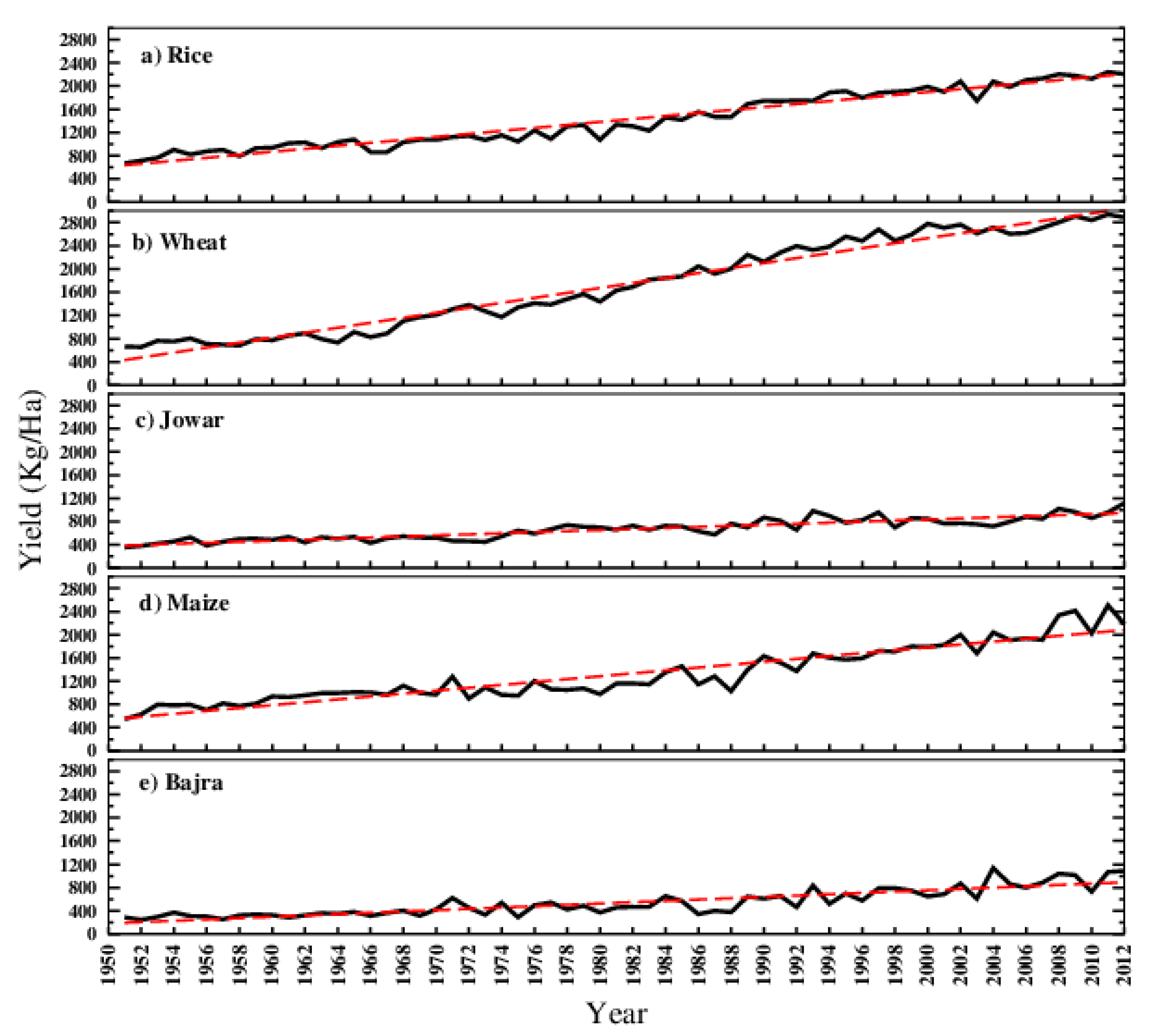
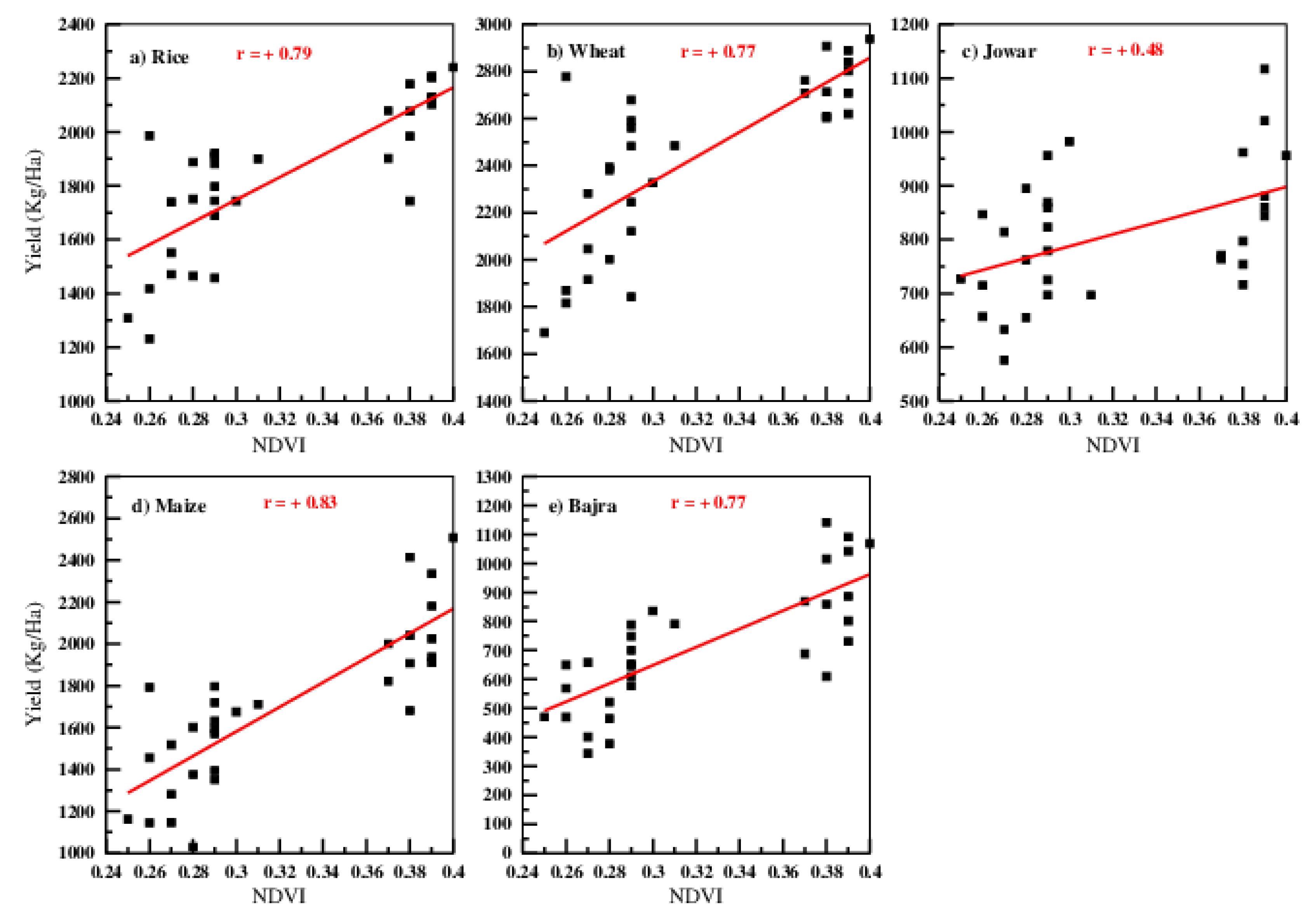

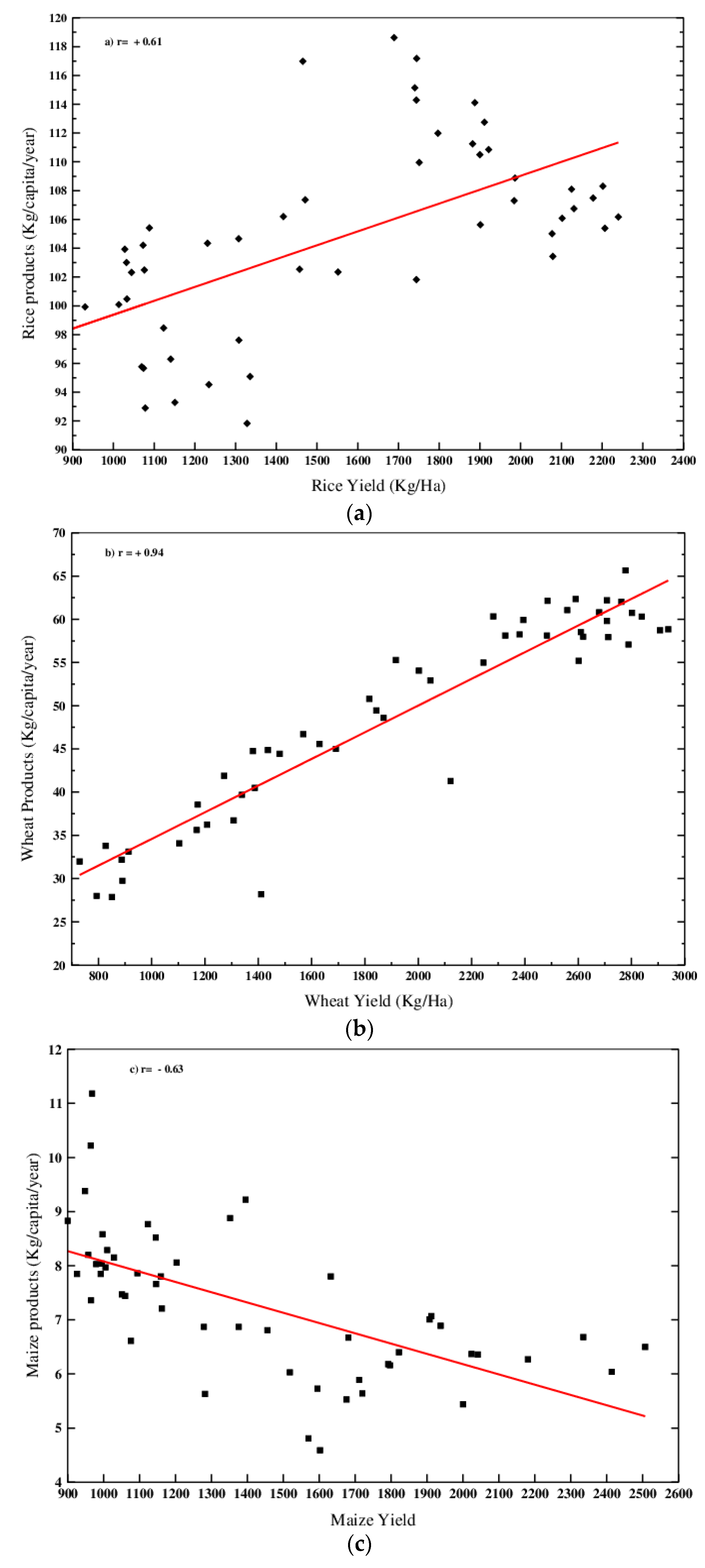
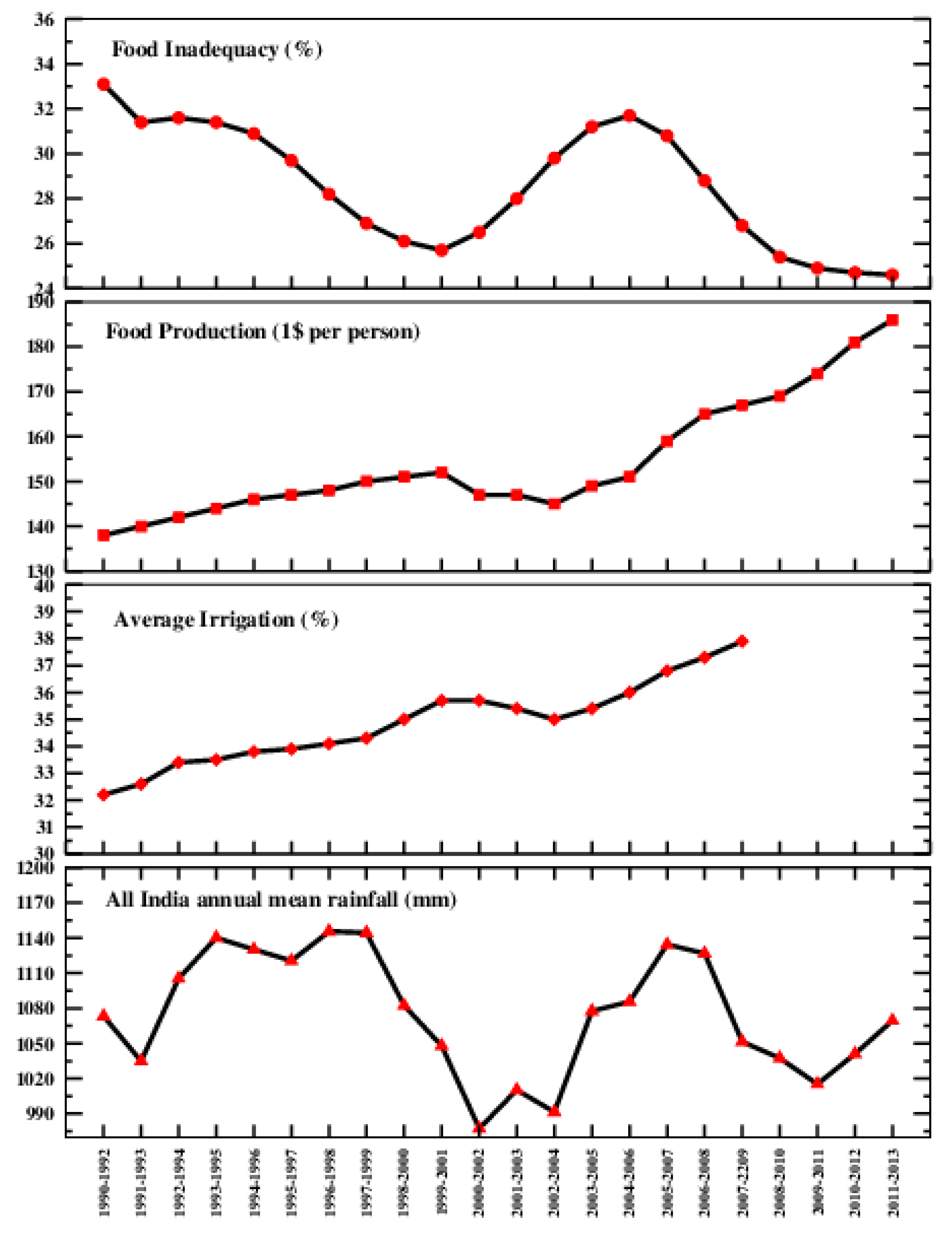
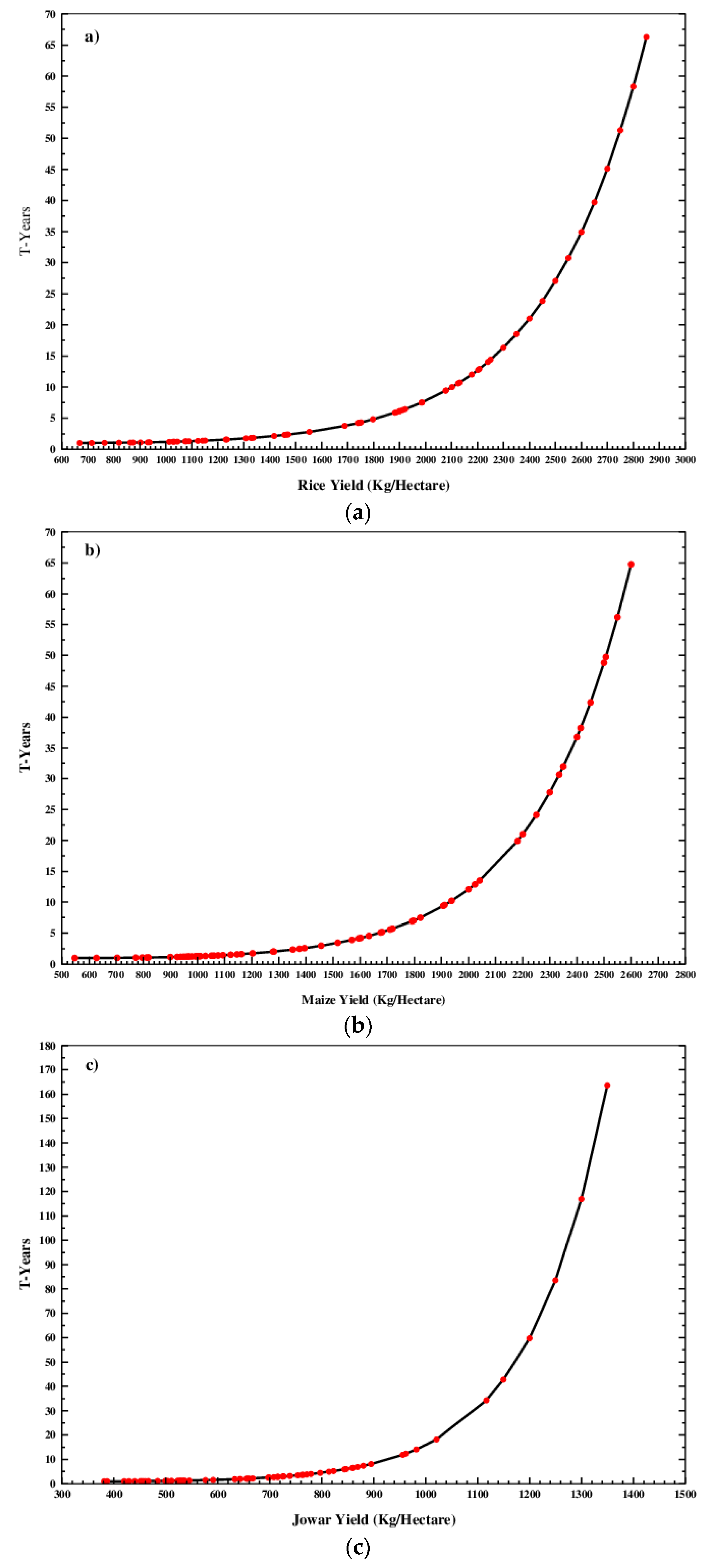
| Crop Yield | Canonical Correlation—1 | Canonical Correlation—2 |
|---|---|---|
| Rice | 0.93 | 0.46 |
| Wheat | 0.97 | 0.46 |
| Maize | 0.93 | 0.25 |
| Jowar | 0.98 | 0.38 |
| Bajra | 0.96 | 0.61 |
© 2019 by the authors. Licensee MDPI, Basel, Switzerland. This article is an open access article distributed under the terms and conditions of the Creative Commons Attribution (CC BY) license (http://creativecommons.org/licenses/by/4.0/).
Share and Cite
Lakshmi Kumar, T.V.; Barbosa, H.; Madhu, S.; Koteswara Rao, K. Studies on Crop Yields and Their Extreme Value Analysis over India. Sustainability 2019, 11, 4657. https://doi.org/10.3390/su11174657
Lakshmi Kumar TV, Barbosa H, Madhu S, Koteswara Rao K. Studies on Crop Yields and Their Extreme Value Analysis over India. Sustainability. 2019; 11(17):4657. https://doi.org/10.3390/su11174657
Chicago/Turabian StyleLakshmi Kumar, T. V., Humberto Barbosa, S. Madhu, and K. Koteswara Rao. 2019. "Studies on Crop Yields and Their Extreme Value Analysis over India" Sustainability 11, no. 17: 4657. https://doi.org/10.3390/su11174657




